Scalable Production of Boron Nitride-Coated Carbon Fiber Fabrics for Improved Oxidation Resistance
Abstract
1. Introduction
2. Materials and Methods
2.1. Materials
2.2. Production Process
2.3. Characterization
2.3.1. Solution Characterizations
2.3.2. Material Characterizations
3. Results
3.1. Solution Characteristics
3.2. Thermal Behavior
3.3. Phase Analysis
3.4. XPS Analysis
3.5. FTIR Analysis
3.6. Raman Analysis
3.7. SEM Analysis
3.8. Oxidation Resistance Properties
4. Discussion
5. Conclusions
Author Contributions
Funding
Data Availability Statement
Acknowledgments
Conflicts of Interest
Abbreviations
| CVD | Chemical Vapor Deposition |
| DTA | Differential Thermal Analysis |
| FTIR | Fourier-Transform Infrared Spectroscopy |
| FWHM | Full Width at Half Maximum |
| NTU | Measured Turbidity |
| SEM | Scanning Electron Microscopy |
| TC | Texture Coefficient |
| TGA | Thermogravimetric Analysis |
| THF | Tetrahydrofuran |
| XPS | X-ray Photoelectron Spectroscopy |
| XRD | X-ray Diffraction |
References
- Bunsell, A.R.; Renard, J. Fundamentals of Fibre Reinforced Composite Materials, 1st ed.; CRC Press: Boca Raton, FL, USA, 2005. [Google Scholar] [CrossRef]
- Panerai, F.; Cochell, T.; Martin, A.; White, J.D. Experimental measurements of the high-temperature oxidation of carbon fibers in oxygen flow. Int. J. Heat Mass Transf. 2019, 136, 184–195. [Google Scholar] [CrossRef]
- Feih, S.; Mouritz, A.P. Tensile properties of carbon fibres and carbon fibre–polymer composites in fire. Compos. Part A Appl. Sci. Manuf. 2012, 43, 765–772. [Google Scholar] [CrossRef]
- Wang, Y.-Q.; Zhou, B.-L.; Wang, Z.-M. Oxidation protection of carbon fibers by coatings. Carbon 1995, 33, 427–433. [Google Scholar] [CrossRef]
- Xia, K.-D.; Lu, C.-X.; Yang, Y. Improving the oxidation resistance of carbon fibers using silicon oxycarbide coatings. Carbon 2015, 93, 1086–1094. [Google Scholar] [CrossRef]
- Zuo, X.; Zhang, L.; Liu, Y.; Cheng, L.; Xia, Y. Oxidation behaviour of two-dimensional C/SiC modified with self-healing Si–B–C coating in static air. Corros. Sci. 2012, 65, 87–93. [Google Scholar] [CrossRef]
- Yang, X.; Chen, Z.-H.; Feng, C. High-temperature protective coatings for C/SiC composites. J. Asian Ceram. Soc. 2014, 2, 305–309. [Google Scholar] [CrossRef]
- Krenkel, W. Carbon fibre reinforced silicon carbide composites (C/SiC, C/C-SiC). Ceram. Eng. Sci. Proc. 2003, 24, 117–148. [Google Scholar] [CrossRef]
- Qi, Y.; Gao, J.; Liang, W.; Miao, Q.; Jia, F.; Chang, X.; Lin, H. A comparison of the tribological properties of SiC coatings prepared via atmospheric plasma spraying and chemical vapor deposition for carbon/carbon composites. Lubricants 2024, 12, 301. [Google Scholar] [CrossRef]
- Zhi, C.; Bando, Y.; Tang, C.; Golberg, D. Engineering of electronic structure of boron-nitride nanotubes by covalent functionalization. Phys. Rev. B 2006, 74, 153413. [Google Scholar] [CrossRef]
- Kim, G.; Lee, D.; Shanker, A.; Shao, L.; Kwon, M.; Gidley, D.; Kim, J.; Pipe, K. High thermal conductivity in amorphous polymer blends by engineered interchain interactions. Nat. Mater. 2015, 14, 295–300. [Google Scholar] [CrossRef]
- Lipp, A.; Schwetz, K.A.; Hunold, K. Boron nitride (BN) and BN composites for high-temperature applications. J. Eur. Ceram. Soc. 2008, 28, 1105–1109. [Google Scholar] [CrossRef]
- Pakdel, A.; Bando, Y.; Golberg, D. Nano boron nitride flatland. Chem. Soc. Rev. 2014, 43, 934–959. [Google Scholar] [CrossRef]
- Oda, K.; Yoshio, T. Oxidation kinetics of hexagonal boron nitride powder. J. Mater. Sci. 1993, 28, 6562–6566. [Google Scholar] [CrossRef]
- Song, C.; Ye, F.; Cheng, L.; Liu, Y.; Zhang, Q. Long-term ceramic matrix composite for aeroengine. J. Adv. Ceram. 2022, 11, 1343–1374. [Google Scholar] [CrossRef]
- Basche, M.; Fanti, R.; Galasso, F. Preparation and properties of silicon carbide-coated boron filaments. Fibre Sci. Technol. 1968, 1, 19–24. [Google Scholar] [CrossRef]
- Chen, X.; Cao, H.; He, Y.; Zhou, Q.; Li, Z.; Wang, W.; He, Y.; Tao, G.; Hou, C. Advanced functional nanofibers: Strategies to improve performance and expand functions. Front. Optoelectron. 2022, 15, 50. [Google Scholar] [CrossRef]
- Zhao, P.; Ren, Z.; Lu, C.; Lv, X.; Yang, Y. Preparation and oxidation resistance property of PyC/BN composite coating on the CF surface. New Chem. Mater. 2022, 50, 86–89. [Google Scholar] [CrossRef]
- Das, M.; Choudhury, A.; Karak, N.; Dolui, S.K. Effect of activation on boron nitride coating on carbon fiber. Ceram. Int. 2011, 37, 527–532. [Google Scholar] [CrossRef]
- Malik, M.W.; Ullah, S.; Wang, B.; Jaddi, S.; Zeng, Y.; Raskin, J.P. Oxygen activated CVD growth of large-area multilayer h-BN on polycrystalline copper foils. J. Cryst. Growth 2023, 606, 127088. [Google Scholar] [CrossRef]
- Coy, E.; Siuzdak, K.; Grądzka-Kurzaj, I.; Sayegh, S.; Weber, M.; Ziółek, M.; Bechelany, M.; Iatsunskyi, I. Exploring the effect of BN and BN bridges on the photocatalytic performance of semiconductor heterojunctions: Enhancing carrier transfer mechanism. Appl. Mater. Today 2021, 24, 101095. [Google Scholar] [CrossRef]
- Nöth, A.; Maier, J.; Schönfeld, K.; Klemm, H. Wet chemical deposition of BN, SiC and Si3N4 interphases on SiC fibers. J. Eur. Ceram. Soc. 2021, 41, 2988–2994. [Google Scholar] [CrossRef]
- Karimzadeh, S.; Safaei, B.; Yuan, C.; Jen, T.C. Emerging atomic layer deposition for the development of high-performance lithium-ion batteries. Electrochem. Energy Rev. 2023, 6, 24. [Google Scholar] [CrossRef]
- Jeong, H.; Kim, D.Y.; Kim, J.; Moon, S.; Han, N.; Lee, S.H.; Okello, O.F.N.; Song, K.; Choi, S.-Y.; Kim, J.K. Wafer-scale and selective-area growth of high-quality hexagonal boron nitride on Ni (111) by metal-organic chemical vapor deposition. Sci. Rep. 2019, 9, 5736. [Google Scholar] [CrossRef]
- Wang, F.; Zhang, X.; Du, Y.; Ou, Y.; Song, Q.; Liu, T.; Wu, X.; Tan, S.; Wang, B. Overall fabrication of uniform BN interphase on 2.5 D-SiC fabric via precursor-derived methods. Vacuum 2024, 230, 113727. [Google Scholar] [CrossRef]
- Hurwitz, F.I.; Chayka, P.V.; Scott, J.M.; Wheeler, D.R. BN and Si-Doped BN Coatings on Woven Fabrics; NASA Technical Report No. NASA/CR-2002-211438; NASA Glenn Research Center: Cleveland, OH, USA, 2002. Available online: https://ntrs.nasa.gov/api/citations/20020072716/downloads/20020072716.pdf (accessed on 18 September 2025).
- Zhou, W.; Xiao, P.; Li, Y.; Zhou, L. Dielectric properties of BN modified carbon fibers by dip-coating. Ceram. Int. 2013, 39, 6569–6576. [Google Scholar] [CrossRef]
- Lii, D.F.; Huang, J.L.; Tsui, L.J.; Lee, S.M. Formation of BN films on carbon fibers by dip-coating. Surf. Coat. Technol. 2002, 150, 269–276. [Google Scholar] [CrossRef]
- Ghanbarian, M.; Naraghi, M. Strength-preserving Continuous Hexagonal Boron Nitride Coatings on Carbon Fibers via B4C as Precursor. Carbon 2025, 241, 120380. [Google Scholar] [CrossRef]
- Badakhsh, A.; Han, W.; Jung, S.C.; An, K.H.; Kim, B.J. Preparation of boron nitride-coated carbon fibers and synergistic improvement of thermal conductivity in their polypropylene-matrix composites. Polymers 2019, 11, 2009. [Google Scholar] [CrossRef]
- Sun, Q.; Ye, W.; Cheng, J.; Long, X. Effects of Boron Nitride Coatings at High Temperatures and Electromagnetic Wave Absorption Properties of Carbon Fiber-Based Magnetic Materials. J. Nanomater. 2020, 2020, 3672517. [Google Scholar] [CrossRef]
- Makurunje, P.; Wesley-Smith, J.; Dziike, F.; Sigalas, I. Nanostructured boron nitride fiber/matrix interphase in carbon-carbon composites. In Ceramic Science and Engineering; Elsevier: Amsterdam, The Netherlands, 2022; pp. 189–212. [Google Scholar] [CrossRef]
- Levy, D.; Zayat, M. (Eds.) The Sol-Gel Handbook, 3 Volume Set: Synthesis, Characterization, and Applications; John Wiley Sons: Hoboken, NJ, USA, 2015; Volume 2. [Google Scholar] [CrossRef]
- Brinker, C.J.; Scherer, G.W. Sol-Gel Science: The Physics and Chemistry of Sol-Gel Processing; Gulf Professional Publishing: Oxford, UK, 1990. [Google Scholar] [CrossRef]
- Jodati, H.; Tezcaner, A.; Evis, Z.; Alshemary, A.Z.; Çelik, E. Synthesis of baghdadite using modified sol–gel route and investigation of its properties for bone treatment applications. J. Korean Ceram. Soc. 2023, 60, 381–398. [Google Scholar] [CrossRef]
- Waghchaure, R.H.; Adole, V.A.; Kushare, S.S.; Shinde, R.A.; Jagdale, B.S. Visible light prompted and modified ZnO catalyzed rapid and efficient removal of hazardous crystal violet dye from aqueous solution: A systematic experimental study. Results Chem. 2023, 5, 100773. [Google Scholar] [CrossRef]
- Çelik, E.; Aybarc, U.; Ebeoğlugil, M.F.; Birlik, İ.; Çulha, O. ITO films on glass substrate by sol–gel technique: Synthesis, characterization and optical properties. J. Sol-Gel Sci. Technol. 2009, 50, 337–347. [Google Scholar] [CrossRef]
- Danks, A.E.; Hall, S.R.; Schnepp, Z. The evolution of ‘sol–gel’ chemistry as a technique for materials synthesis. Mater. Horiz. 2016, 3, 91–112. [Google Scholar] [CrossRef]
- Hsueh, T.J.; Hsu, C.L.; Chang, S.J.; Chen, I.C. Laterally grown ZnO nanowire ethanol gas sensors. Sens. Actuators B Chem. 2007, 126, 473–477. [Google Scholar] [CrossRef]
- Baitalow, F.; Baumann, J.; Wolf, G.; Jaenicke-Rößler, K.; Leitner, G. Thermal decomposition of B–N–H compounds investigated by using combined thermoanalytical methods. Thermochim. Acta 2002, 391, 159–168. [Google Scholar] [CrossRef]
- Bowden, M.; Autrey, T.; Brown, I.; Ryan, M. The thermal decomposition of ammonia borane: A potential hydrogen storage material. Curr. Appl. Phys. 2008, 8, 498–500. [Google Scholar] [CrossRef]
- Zhong, B.; Zhao, G.; Huang, X.; Zhang, X.; Chen, J.; Ren, H.; Wen, G. A facile route to high-purity BN nanoplates with ultraviolet cathodoluminescence emissions at room temperature. Mater. Res. Bull. 2014, 53, 190–195. [Google Scholar] [CrossRef]
- Babenko, V.; Lane, G.; Koos, A.A.; Murdock, A.T.; So, K.; Britton, J.; Meysami, S.S.; Moffat, J.; Grobert, N. Time dependent decomposition of ammonia borane for the controlled production of 2D hexagonal boron nitride. Sci. Rep. 2017, 7, 14297. [Google Scholar] [CrossRef] [PubMed]
- Kumar, A.; Malik, G.; Pandey, M.K.; Chandra, R.; Mulik, R.S. Corrosion behavior of pulse laser deposited 2D nanostructured coating prepared by self-made h-BN target in salinity environment. Ceram. Int. 2021, 47, 12537–12546. [Google Scholar] [CrossRef]
- Zhu, M.; Shao, Y.; Xin, Y.; Yang, D.; Lu, X.; Zhang, H. Anisotropic dielectric dispersions and thermal behaviors in highly textured BN thin films for heat self-dissipating electronics. Vacuum 2024, 225, 113207. [Google Scholar] [CrossRef]
- Barrett, C.S.; Massalski, T.B. Structure of Metals: Crystallographic Methods, Principles, and Data, 3rd ed.; Pergamon Press: South Croydon, UK, 1980. [Google Scholar]
- Aksoy, S. Physical Characterization of Nano-Structured Metal Oxide Films Obtained by Sol Gel Spin Coating Method. Doctoral Dissertation, Anadolu University, Institute of Science and Technology, Eskişehir, Turkey, 2017. [Google Scholar]
- Vyazovkin, S.; Koga, N.; Schick, C. (Eds.) Handbook of Thermal Analysis and Calorimetry: Recent Advances, Techniques and Applications; Elsevier: Amsterdam, The Netherlands, 2018. [Google Scholar]
- Zhang, Y.; Lin, B.; Fu, Z.; Liu, C.; Han, W. Strong ultraviolet emission and rectifying behavior of nanocrystalline ZnO films. Opt. Mater. 2006, 28, 1192–1196. [Google Scholar] [CrossRef]
- Bura, M.; Singh, G.; Gupta, D.; Malik, N.; Salim, A.; Kumar, A.; Singhal, R.; Kumar, S.; Aggarwal, S. Transition in the preferred orientation of RF sputtered ZnO/Si thin films by thermal annealing: Structural, morphological, and optical characteristics. Opt. Mater. 2022, 133, 113024. [Google Scholar] [CrossRef]
- Budak, E.; Bozkurt, Ç. Synthesis of hexagonal boron nitride with the presence of representative metals. Phys. B Condens. Matter 2010, 405, 4702–4705. [Google Scholar] [CrossRef]
- Sun, T.; Tu, J.; Zhou, Z.; Sun, R.; Zhang, X.; Li, H.; Xu, Z.; Peng, Y.; Liu, X.; Wangyang, P.; et al. Resistive switching of self-assembly stacked h-BN polycrystal film. Cell Rep. Phys. Sci. 2022, 3, 100939. [Google Scholar] [CrossRef]
- Jia, S.; Chen, W.; Zhang, J.; Lin, C.Y.; Guo, H.; Lu, G.; Li, K.; Zhai, T.; Ai, Q.; Lou, J. CVD growth of high-quality and large-area continuous h-BN thin films directly on stainless-steel as protective coatings. Mater. Today Nano 2021, 16, 100135. [Google Scholar] [CrossRef]
- Bashir, A.; Maqbool, M.; Lv, R.; Usman, A.; Guo, H.; Aftab, W.; Niu, H.; Liu, M.; Bai, S.L. Surface modified boron nitride towards enhanced thermal and mechanical performance of thermoplastic polyurethane composite. Compos. Part B Eng. 2021, 218, 108871. [Google Scholar] [CrossRef]
- Xu, Z.; Chen, Y.; Li, W.; Li, J.; Yu, H.; Liu, L.; Wu, G.; Yang, T.; Luo, L. Preparation of boron nitride nanosheet-coated carbon fibres and their enhanced antioxidant and microwave-absorbing properties. RSC Adv. 2018, 8, 17944–17949. [Google Scholar] [CrossRef]
- Nehate, S.D.; Saikumar, A.K.; Prakash, A.; Sundaram, K.B. A review of boron carbon nitride thin films and progress in nanomaterials. Mater. Today Adv. 2020, 8, 100106. [Google Scholar] [CrossRef]
- Ramteke, S.M.; Chelladurai, H. Effects of hexagonal boron nitride based nanofluid on the tribological and performance, emission characteristics of a diesel engine: An experimental study. Eng. Rep. 2020, 2, 12216. [Google Scholar] [CrossRef]
- Fenetaud, P.; Jacques, S. SiC/SiC ceramic matrix composites with BN interphase produced by gas phase routes: An overview. Open Ceram. 2023, 15, 100396. [Google Scholar] [CrossRef]
- Li, J.S.; Zhang, C.R.; Li, B. Preparation and characterization of boron nitride coatings on carbon fibers from borazine by chemical vapor deposition. Appl. Surf. Sci. 2011, 257, 7155–7160. [Google Scholar] [CrossRef]
- Rousseas, M.; Mickelson, W.; Zettl, A.K. Boron Nitride Converted Carbon Fiber. U.S. Patent No. 9,305,677, 2016. [Google Scholar]
- Ghanbarian, M.; Naraghi, M. Hexagonal boron nitride coatings for thermally resistant and strong carbon fibers. SSRN Electron. J. 2024, 1–19. [Google Scholar] [CrossRef]
- Xiao, P.; Liu, Z.; Li, Z.C.; Zhang, B.; Li, Z.; Li, Y. Oxidation behavior of carbon/carbon-boron nitride composites fabricated by additives and chemical vapor infiltration. Ceram. Int. 2019, 45, 4335–4341. [Google Scholar] [CrossRef]
- Frueh, S.; Kellett, R.; Mallery, C.; Molter, T.; Willis, W.S.; Kingondu, C.; Suib, S.L. Pyrolytic decomposition of ammonia borane to boron nitride. Inorg. Chem. 2010, 50, 783–792. [Google Scholar] [CrossRef]
- Arık, M.N.; Yıldırım, C.; Solak, N. Improving the oxidation resistance of carbon fibers via B4C coating by modified boron oxide chemical vapor deposition. Solid State Sci. 2023, 146, 107367. [Google Scholar] [CrossRef]
- Li, L.H.; Cervenka, J.; Watanabe, K.; Taniguchi, T.; Chen, Y. Strong oxidation resistance of atomically thin boron nitride nanosheets. ACS Nano 2014, 8, 1457–1462. [Google Scholar] [CrossRef]
- Sarma, S.S.; Padya, B.; Sarada, B.V.; Akhila, V.; Gowthami, C.; Krishna, P.V.; Joardar, J. Two-dimensional hexagonal boron nitride by cryo-milling: Microstructure and oxidation behavior at elevated temperature. J. Nanoparticle Res. 2024, 26, 80. [Google Scholar] [CrossRef]
- Shen, T.; Liu, S.; Yan, W.; Wang, J. Highly efficient preparation of hexagonal boron nitride by direct microwave heating for dye removal. J. Mater. Sci. 2019, 54, 8852–8859. [Google Scholar] [CrossRef]
- Bresnehan, M.S.; Hollander, M.J.; Wetherington, M.; Wang, K.; Miyagi, T.; Pastir, G.; Snyder, D.W.; Gengler, J.J.; Voevodin, A.A.; Mitchel, W.C.; et al. Prospects of direct growth boron nitride films as substrates for graphene electronics. J. Mater. Res. 2014, 29, 459–471. [Google Scholar] [CrossRef]
- Sauder, C.; Lamon, J.; Pailler, R. The tensile behaviour of carbon fibres at high temperatures up to 2400 °C. Carbon 2004, 42, 715–725. [Google Scholar] [CrossRef]
- Toray Carbon Fibers. Toray T700S/T800S Technical Data Sheet; Toray Composite Materials America, Inc.: Tacoma, WA, USA, 2023; Available online: https://www.toraycma.com/resources/carbon-fiber-terminology/ (accessed on 18 September 2025).
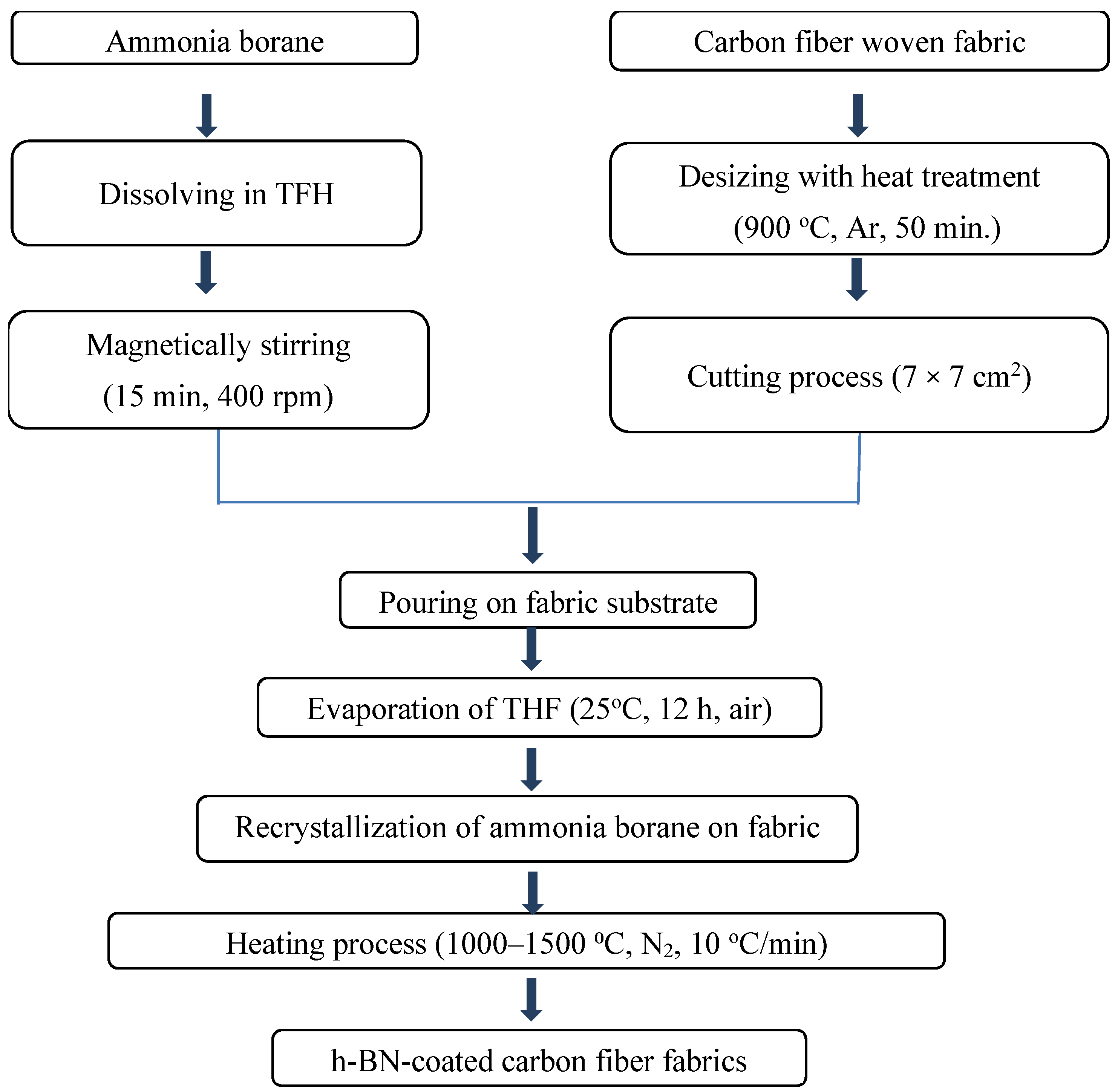







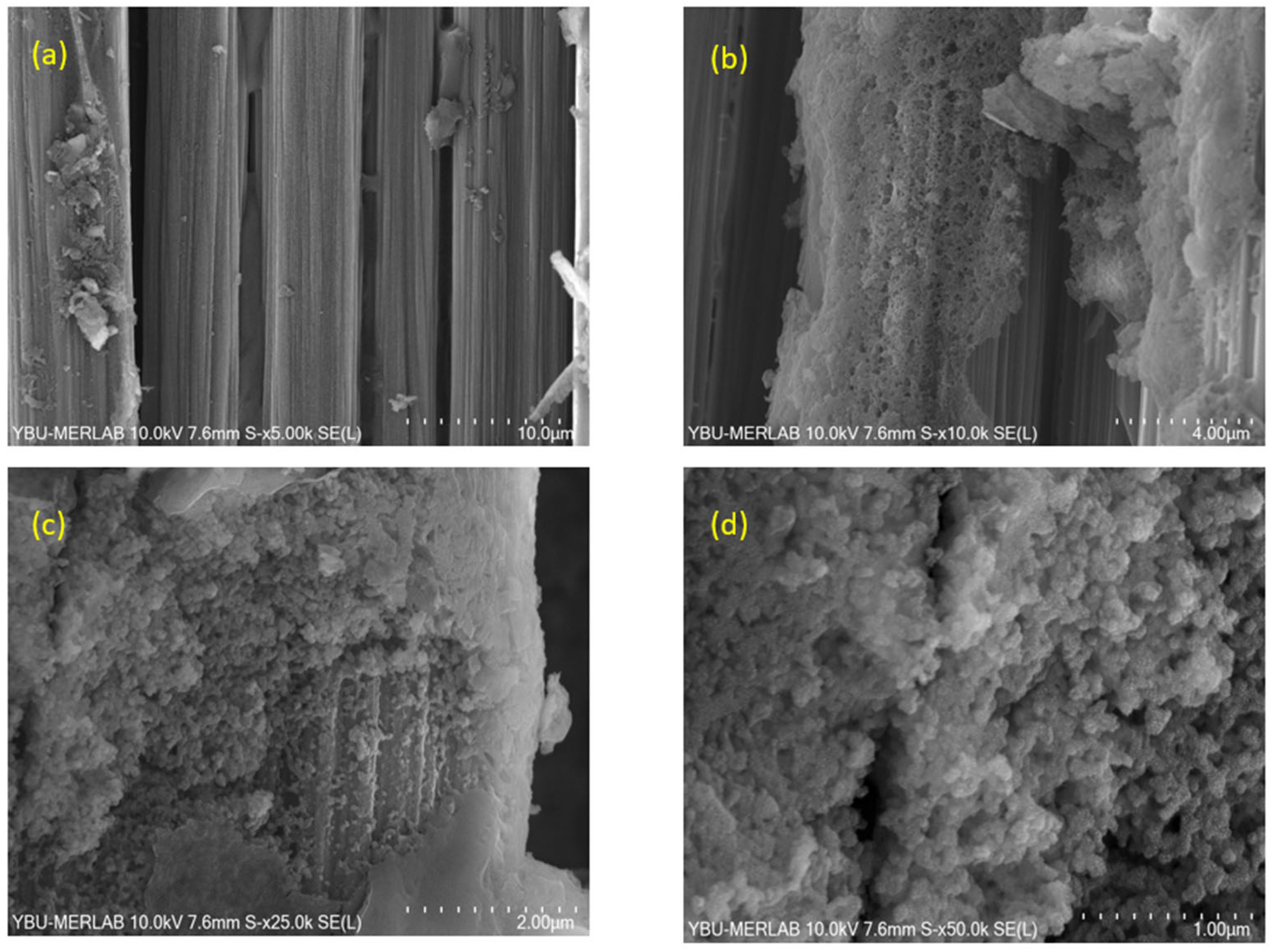

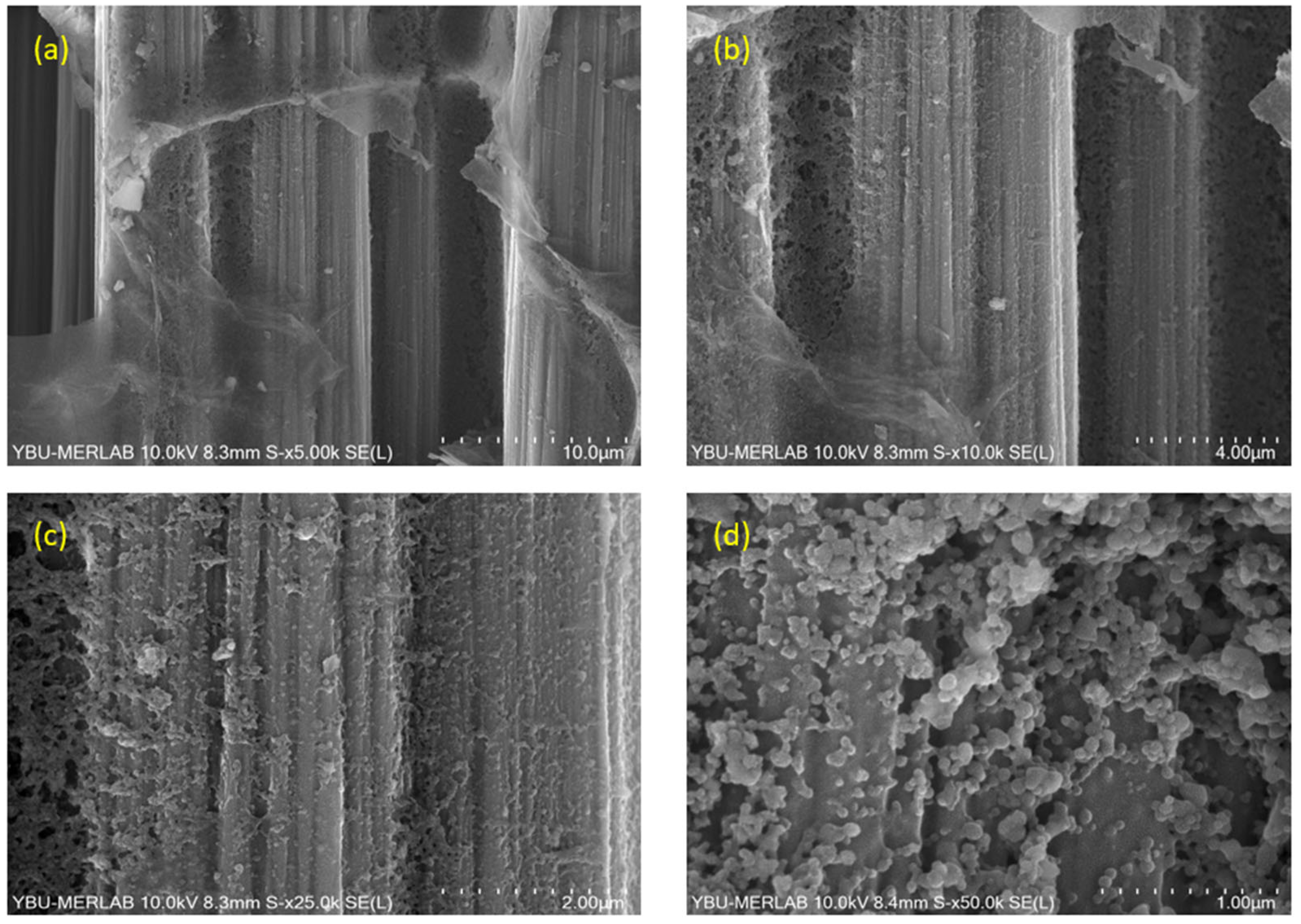
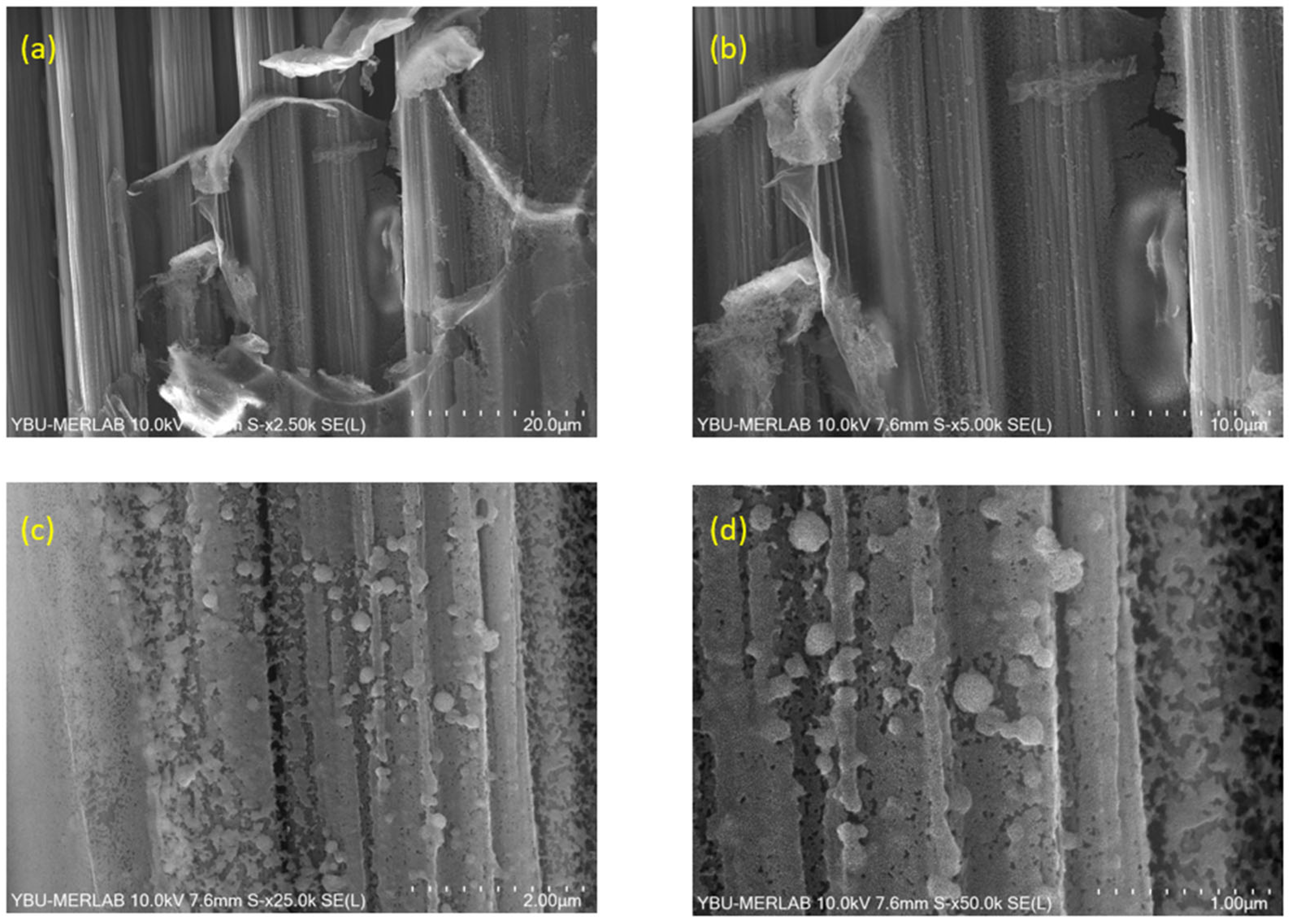
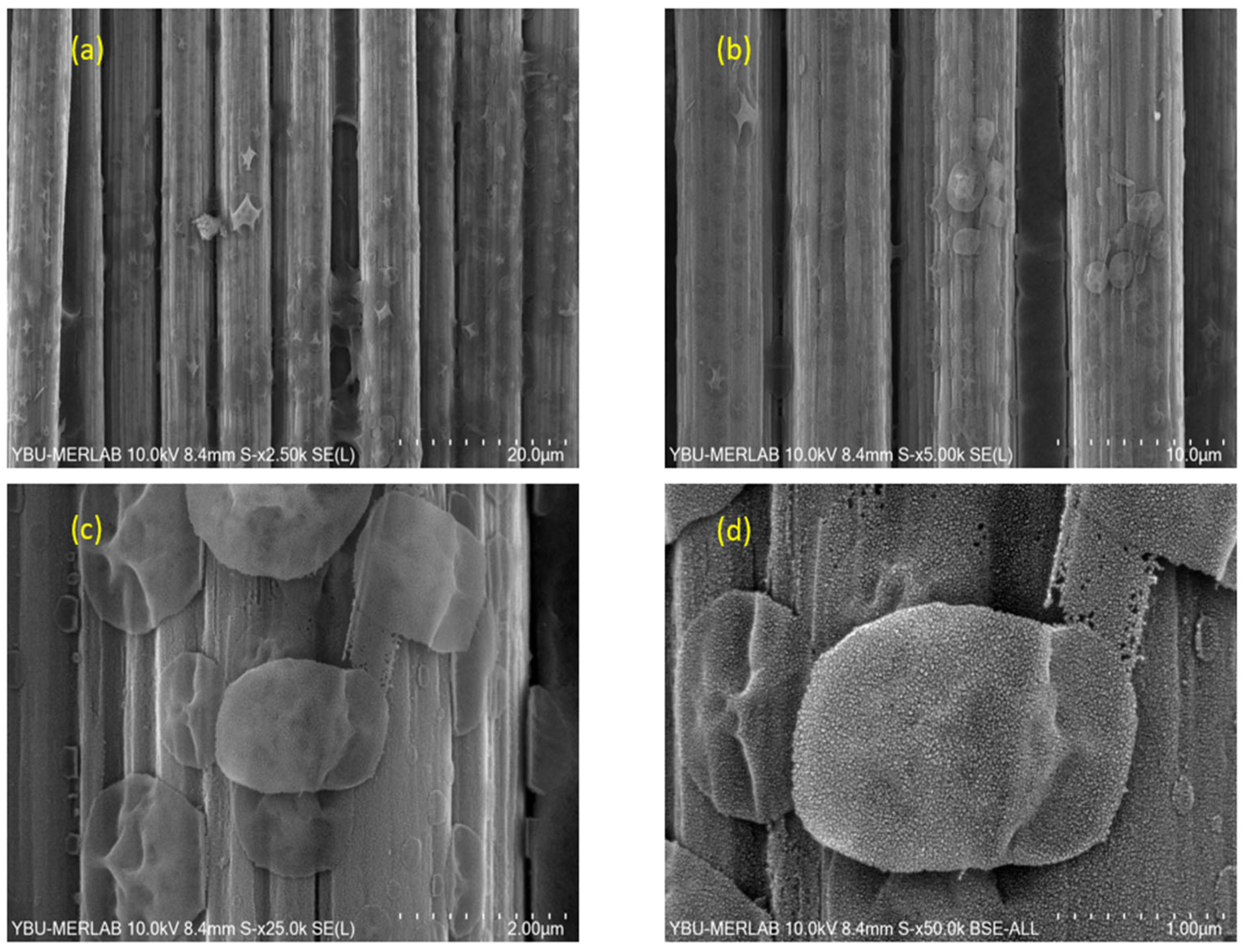


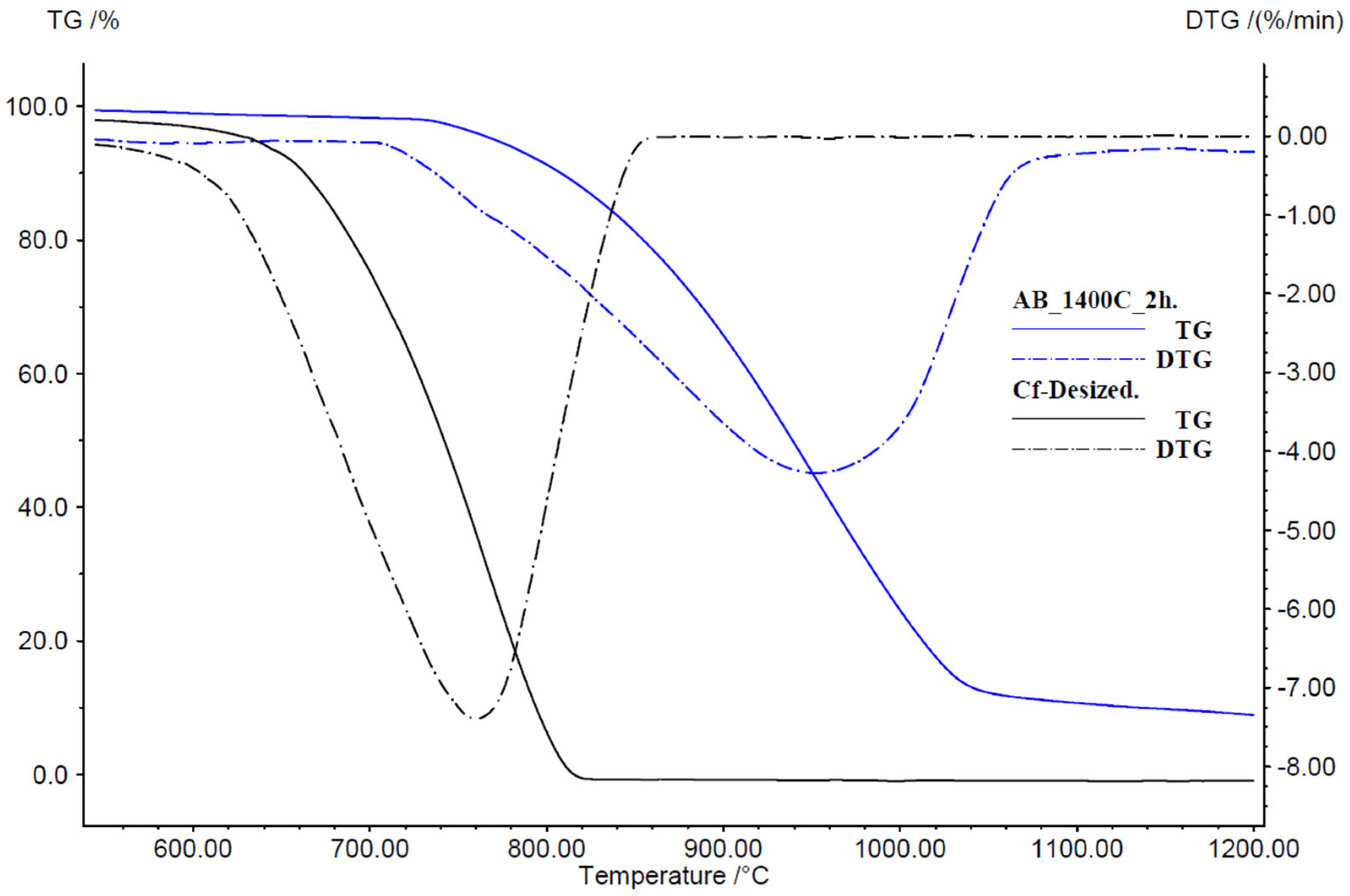
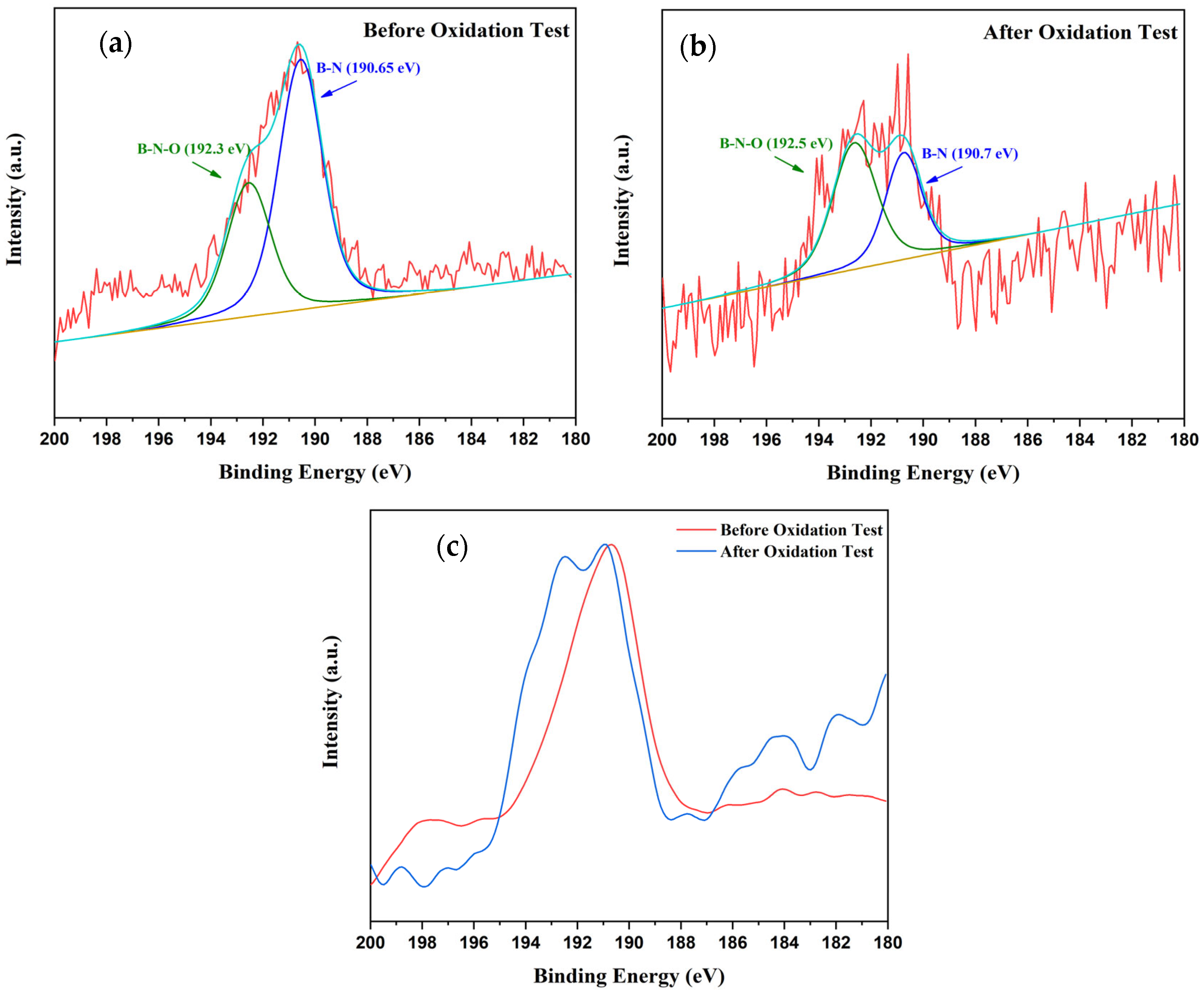
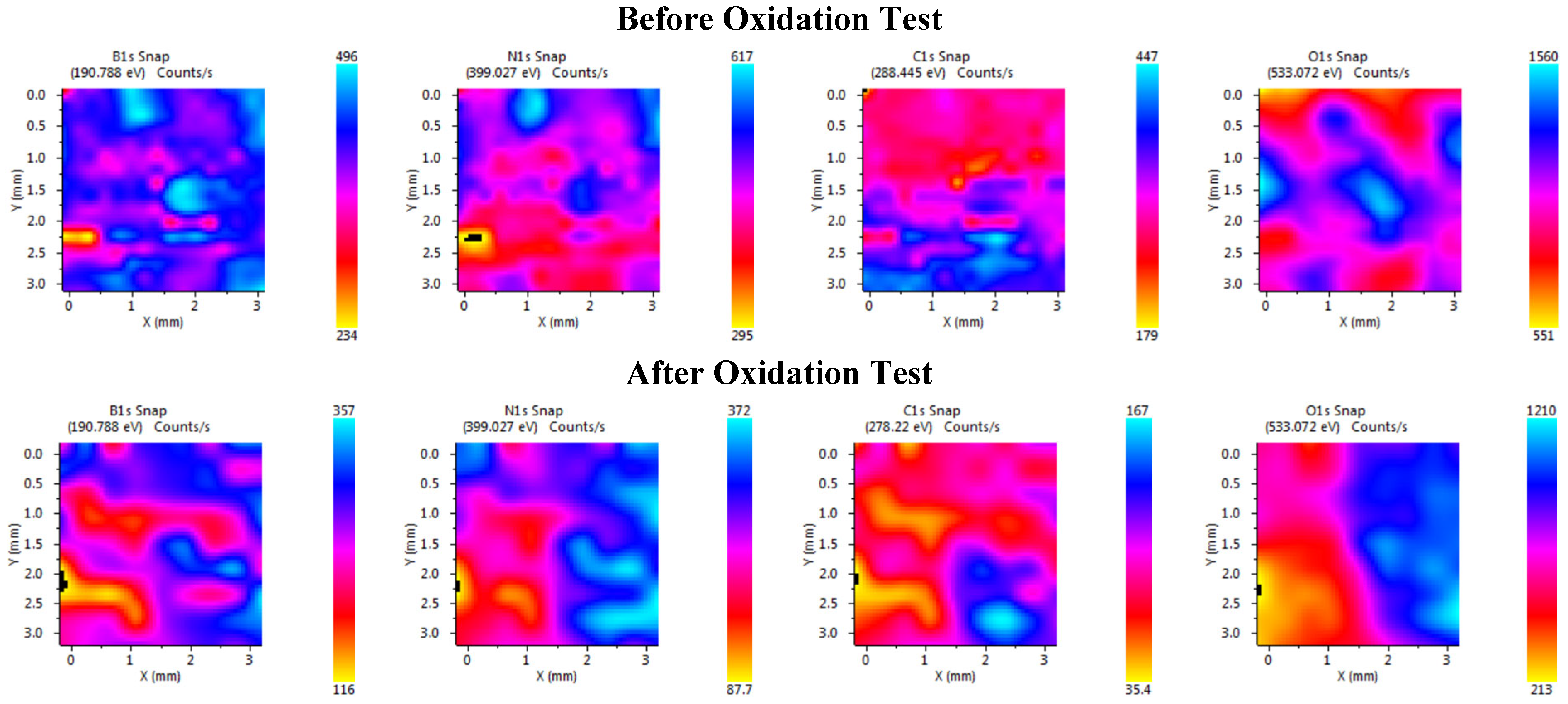
| Chemical Type | Materials | Formula | Purity (%) | Molar Weight (g/mol) |
|---|---|---|---|---|
| Precursors | Ammonium formate | NH4HCO2 | 97.00 | 63.06 |
| Sodium borohydride | NaBH4 | 99.00 | 37.83 | |
| Solvent | Tetrahydrofuran (THF) | C4H8O | 99.00 | 71.11 |
| Substrate | Carbon fiber woven fabric | C | 99.99 | 12.01 |
| Solution | Measured Turbidity (NTU) | Measured pH Value |
|---|---|---|
| BNH6 | 134.20 | 7.58 |
| Samples/Temp. | (hkl) | 2θ (°) | FWHM (o) | d (Å) | a = b (Å) | c (Å) | TC | C (%) | D (nm) | δ (1/nm3) |
|---|---|---|---|---|---|---|---|---|---|---|
| 1000 °C | (002) | 26.55 | 0.80 | 3.35 | - | - | - | 47 | 10.25 | 9.5 × 10−3 |
| 1100 °C | (002) | 25.14 | 1.26 | 3.40 | - | - | - | 67 | 6.90 | 0.021 |
| 1200 °C | (002) | 28.02 | 0.272 | 3.18 | - | - | - | 74 | 31.60 | 1.0 × 10−3 |
| 1300 °C | (002) | 25.82 | 3.86 | 3.45 | 2.4770 | 6.88 | 0.85 | 100 | 2.23 | 0.20 |
| 1400 °C | (002) | 26.72 | 0.35 | 3.35 | 2.5036 | 6.70 | 1.00 | 100 | 10.10 | 0.06 |
| 1500 °C | (002) | 26.47 | 1.14 | 3.37 | 2.4960 | 6.72 | 1.00 | 100 | 7.72 | 0.12 |
| Temperature | B1s | N1s | O1s | C1s |
|---|---|---|---|---|
| 1000 °C | 190.72 eV | 398.07 eV | 532.59 eV | 284.61 eV |
| 1100 °C | 190.73 eV | 398.22 eV | 532.68 eV | 284.67 eV |
| 1200 °C | 190.73 eV | 398.22 eV | 532.68 eV | 284.67 eV |
| 1300 °C | 190.52 eV | 398.06 eV | 532.40 eV | 284.55 eV |
| 1400 °C | 190.40 eV | 397.99 eV | 532.39 eV | 284.47 eV |
| 1500 °C | 190.40 eV | 397.99 eV | 532.39 eV | 287.47 eV |
| Temperature | B1s | N1s | O1s | C1s |
|---|---|---|---|---|
| 1000 °C | 39.83 | 25.23 | 24.17 | 10.77 |
| 1100 °C | 41.20 | 30.45 | 17.73 | 10.62 |
| 1200 °C | 36.02 | 29.39 | 10.45 | 24.14 |
| 1300 °C | 42.62 | 35.60 | 11.36 | 10.43 |
| 1400 °C | 40.22 | 34.44 | 8.10 | 17.24 |
| 1500 °C | 40.91 | 36.73 | 6.44 | 15.92 |
| State | Name | Peak BE | FWHM | Atomic % |
|---|---|---|---|---|
| Before Oxidation | B-N | 190.65 | 2 | 64.99 |
| B-N-O | 192.30 | 2 | 35.01 | |
| After Oxidation | B-N | 190.70 | 1.31 | 38.54 |
| B-N-O | 192.50 | 2 | 61.46 |
Disclaimer/Publisher’s Note: The statements, opinions and data contained in all publications are solely those of the individual author(s) and contributor(s) and not of MDPI and/or the editor(s). MDPI and/or the editor(s) disclaim responsibility for any injury to people or property resulting from any ideas, methods, instructions or products referred to in the content. |
© 2025 by the authors. Licensee MDPI, Basel, Switzerland. This article is an open access article distributed under the terms and conditions of the Creative Commons Attribution (CC BY) license (https://creativecommons.org/licenses/by/4.0/).
Share and Cite
Yıldırım Elçin, C.; Arık, M.N.; Örs, K.; Nakaş, U.; Yakışık Özgüle, Z.B.; Acar, Ö.; Aslanlar, S.; Altay, Ö.; Çelik, E.; Şahin, K. Scalable Production of Boron Nitride-Coated Carbon Fiber Fabrics for Improved Oxidation Resistance. J. Compos. Sci. 2025, 9, 564. https://doi.org/10.3390/jcs9100564
Yıldırım Elçin C, Arık MN, Örs K, Nakaş U, Yakışık Özgüle ZB, Acar Ö, Aslanlar S, Altay Ö, Çelik E, Şahin K. Scalable Production of Boron Nitride-Coated Carbon Fiber Fabrics for Improved Oxidation Resistance. Journal of Composites Science. 2025; 9(10):564. https://doi.org/10.3390/jcs9100564
Chicago/Turabian StyleYıldırım Elçin, Cennet, Muhammet Nasuh Arık, Kaan Örs, Uğur Nakaş, Zeliha Bengisu Yakışık Özgüle, Özden Acar, Salim Aslanlar, Özkan Altay, Erdal Çelik, and Korhan Şahin. 2025. "Scalable Production of Boron Nitride-Coated Carbon Fiber Fabrics for Improved Oxidation Resistance" Journal of Composites Science 9, no. 10: 564. https://doi.org/10.3390/jcs9100564
APA StyleYıldırım Elçin, C., Arık, M. N., Örs, K., Nakaş, U., Yakışık Özgüle, Z. B., Acar, Ö., Aslanlar, S., Altay, Ö., Çelik, E., & Şahin, K. (2025). Scalable Production of Boron Nitride-Coated Carbon Fiber Fabrics for Improved Oxidation Resistance. Journal of Composites Science, 9(10), 564. https://doi.org/10.3390/jcs9100564






